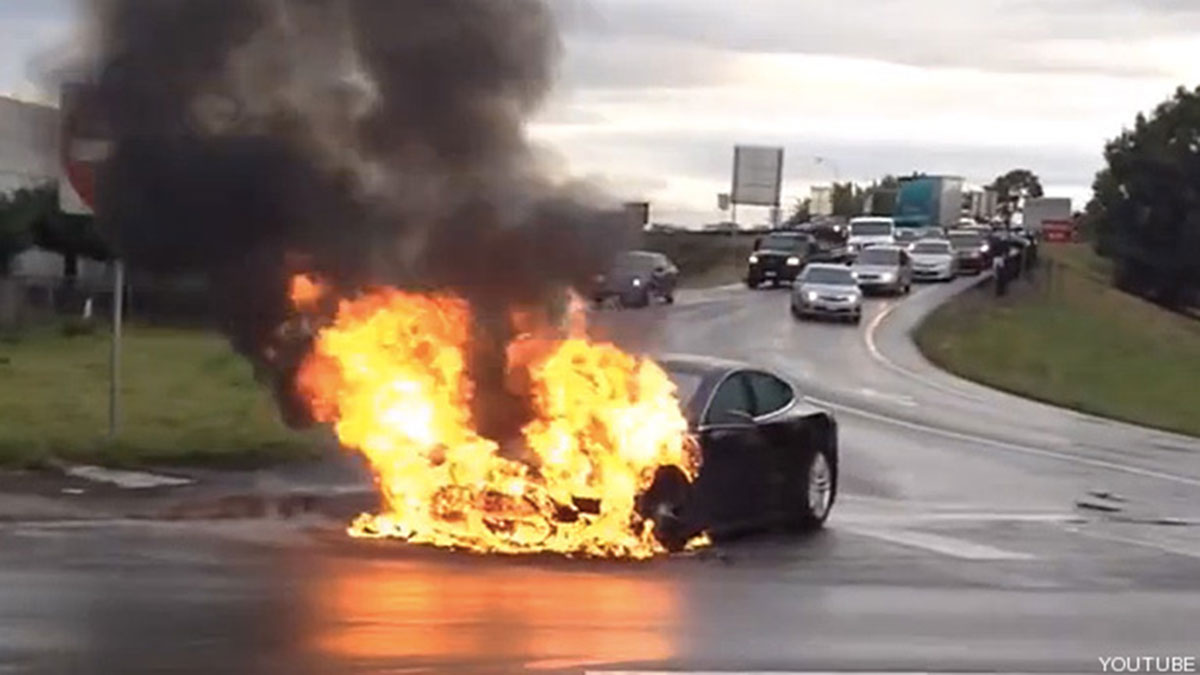Do we really want to replace gas cars with e-vehicles?
Calling for Life Cycle Analysis of EVs: Part 2
a report on nature and technology
by Katie Singer

One fire truck holds 500 gallons
(1893 liters) of water.
I can’t resist starting this article with a quiz:
1. How much water does it take to put out a (gas-powered) internal combustion engine vehicle (ICEV) fire?
About 300 gallons (1136 liters).
2. How much water does one U.S. fire truck hold?
About 500 gallons (1893 liters).
3. How much water does it take to extinguish an electric vehicle fire?
Between 20,000 and 30,000 gallons (75,708 and 105,992 liters). (Each month, the fire department in Woodland Township, Texas [population 114,000] uses about 28,000 gallons.)[1]

A Tesla fire can take up to 24 hours to extinguish.
Just like a trick birthday candle, an EV battery pack can reignite several times. To ensure
that it’s completely extinguished, Tesla’s Model S Emergency Response Guide advises monitoring “high voltage battery temperature for at least 24 hours” after the vehicle catches fire.[2]
After several General Motors’ Bolts caught fire early this summer, GM told EV owners to park their vehicles outdoors immediately after charging and not to charge them overnight.[3]
When they burn, EV batteries emit more than 100 toxic substances, including hydrogen fluoride, hydrochloric acid, carbon dioxide, hydrogen cyanide, sulfur dioxide, soot particles that include high concentrations of zinc, lead, chlorine and heavy metal including cobalt oxide, nickel oxide and manganese oxide. An EV fire produces up to 60% more hydrogen fluoride than an ICEV fire.[4]
Unless they’re properly masked, passengers, firefighters and others can inhale these toxins or absorb them through their skin.[5]
Washing firefighters’ clothing also consumes water. Like the water used to extinguish the fire, water used to launder exposed clothes can contaminate nearby soil and waterways.
Routinely, I hear commentators push for electric trucks and schoolbuses (vehicles that require battery packs larger than a Tesla). How much water will it take to extinguish those vehicles if they catch fire?
Here’s another challenge: who’s liable for determining that an EV fire is extinguished and will not reignite—the fire department, the car owner, or the car manufacturer?
Whatever happened to due diligence?
In 2019, the U.S. saw 189,500 vehicle fires.[6] EVs catch fire less often than gas-powered vehicles—but only two percent of 2021’s new U.S. vehicles are EVs. If 40 percent of all vehicles go electric, as Joe Biden aims,[7] won’t that increase the number of electric vehicle fires?
EVs have caught fire while they charge, stand still in a driveway, drive along a road or highway and when they crash. To make them lighter, cars have lots of plastics now—which increases their flammability. If an EV fire progresses into the battery pack, the fire can be intense.
Hybrid vehicle fires typically won’t be as intense as EV fires since their batteries are typically smaller than EV batteries—but larger than those in gas-powered cars. The larger the battery, the more mileage per charge—and the more burnable material the vehicle carries. One EV’s battery pack can carry enough fuel to power a U.S. household for two days.
In the U.S., only 10% of firefighters are properly trained to extinguish an EV fire.[8] The National Transportation Safety Board has neither regulatory nor enforcement power to require manufacturers to develop emergency response guidelines for fighting high-voltage lithium-ion battery fires.
In June, the state of California asked EV owners to charge their vehicles only during the day.[9] I didn’t understand this directive. Efficient delivery of electricity is like efficient driving: stopping and starting uses more energy than smooth delivery of power or steady highway driving. Since electricity demands are much higher during the day, I expected utilities to encourage night-time charging. An electrical engineer-friend speculated that because of excess energy generated by rooftop solar systems—daytime EV charging could help ease utilities’ excesses—and balance voltage control. (Excess energy can cause power surges. Utilities must sell their excesses to other utilities.)
In other words, new technologies add complexity to our already complex systems—but we’ve not mitigated the hazards.
A few items EV evaluations tend not to include
As I reported last Fall,[10] evaluations of EVs’ greenhouse gas and toxic emissions typically calculate only the vehicle’s emissions while operating. Evaluations tend to exclude:
- The extractions, energy use, and greenhouse gases and toxins embodied in manufacturing every EV and charging station. The vast majority of energy use and emissions occur before end-users turn their vehicles on for the first time. EV evaluations should include the energy used and waste generated to mine and refine copper, lithium, neodymium, praseodymium, dysprosium, yttrium, terbium, cerium, lanthanum, zirconium and other raw materials that go into it. I’ve read claims that one new EV’s cobalt, lithium and nickel could fit neatly into a football. This ignores the impacts to the ecosystems and communities wherein those ores were extracted or refined. For one example, a gas-powered car has about 50 pounds (22.6 kilograms) of copper; each EV uses about 184 pounds (83 kilograms) of copper.[11] For every kilogram of copper mined, 21 kilograms of waste are generated.[12]
- Evaluations tend not to calculate the electricity used to recharge EV batteries. If France replaced all of its vehicles with electric ones, the country’s energy demands would double. Generating this much electricity with the least amount of greenhouse gas emissions means building many new nuclear reactors.[13]
- Inter-continental shipping (powered by dirty, ocean-acidifying bunker fuel) to transport extracted ores, smelted ores, solvents (etc.) for every vehicle’s circuit boards, batteries, sensors, etc.
- The ecological impacts of discarding or recycling the hundreds of elements in every vehicle and charging station.
- When a hybrid recharges its battery at stoplights, the magnetic fields emitted by the vehicle’s computers can shut off a deep brain stimulator (a medical implant installed for Parkinson’s and other neuro-muscular diseases). In the U.S., at least 10% of the population has an implant—a cardiac pacemaker, deep brain stimulator, insulin pump, cochlear implant. Embedding EV chargers within roadways could be fatal for some people with implants.
Do we count “net-zero” or “real” emissions?
Like EU Commissioner Ursula von der Leyen, President Biden calls EVs “sustainable,” “zero-emitting” and “clean.” My city’s environmental services department encourages its citzens to “Change to Electric Now: switching to an electric vehicle reduces your greenhouse gas emissions by 70%.” By 2030, Biden wants 40 percent of U.S. drivers using electric vehicles (EVs). [14]
I just don’t get it. Manufacturing ANYTHING takes tremendous extraction and energy and emits tremendous amounts of greenhouse gas and toxic waste. The only way to call an EV sustainable, zero-emitting or clean is to look exclusively at greenhouse gases while it operates—and to exclude everything that goes into manufacturing and discarding the vehicle and charging stations—while ignoring EVs’ fire risks.
If we aim to remove more carbon from the atmosphere than we emit, then looking at emissions state-by-state or country-by-country does not work. We need to look at the whole world’s emissions. Greenhouse gas emissions from Chinese smelters that manufacture polysilicon for EVs should go into every EV purchaser’s carbon calculator. To be real, every analysis has to be cradle-to-grave.
Closing questions
Before allowing anyone to purchase (or drive?) an electric vehicle, should every municipality determine how much water it has available to extinguish EV fires and, thereby how many EVs it can permit to park or drive within its limits? Should municipalities create a fire service fee for EV owners?
If a municipality aims to decrease its greenhouse gas emissions, extractions, worker hazards and impacts to wildlife, should it include the cradle-to-grave impacts of anything purchased within its limits?
REFERENCES
[1]. https://www.popsci.com/story/technology/electric-vehicle-battery-tesla-fire/ https://sfist.com/2021/06/22/as-tesla-fires-require-outlandish-volumes-of-water-to-extinguish-firefighters-grapple-with-ev-batteries/
[2]. https://sfist.com/2021/06/22/as-tesla-fires-require-outlandish-volumes-of-water-to-extinguish-firefighters-grapple-with-ev-batteries/
[3]. https://www.cnbc.com/2021/07/14/gm-warns-some-bolt-ev-owners-dont-park-them-inside-or-charge-them-unattended-overnight.html
[4]. http://www.diva-portal.org/smash/get/diva2:1522149/FULLTEXT01.pdf
[5]. https://eepower.com/news/100-toxic-gases-from-li-ions-its-not-just-about-fires/ https://www.sciencedirect.com/science/article/abs/pii/S0304389419308696; Swiss Federal Laboratories for Materials Science and Technology (EMPA). “How dangerous are burning electric cars? Fire experiments in test tunnel.” ScienceDaily. ScienceDaily, 1 September 2020. www.sciencedaily.com/releases/2020/09/200901112208.htm
https://airqualitynews.com/2020/10/09/electric-vehicle-fires-should-we-be-concerned/
[6]. https://www.statista.com/statistics/377006/nmber-of-us-highway-vehicle-fires/
[7]. Tom Krisher and Hope Yen, “Biden eyes aggressive emissions rules, push toward EVs,” Associated Press, July 28, 2021.
[8]. https://www.nbcnews.com/business/autos/federal-regulators-warn-risks-firefighters-electrical-vehicle-fires-n1271084
[9]. https://www.newsweek.com/california-facing-power-crisis-frets-over-electric-car-charging-routines-1602755
[10]. www.OurWeb.tech/letter-5
[11]. https://www.youtube.com/watch?v=6LBC8ntzgIA
[12]. Goonan, Thomas G., “Flows of selected materials associated with world copper melting,” U.S. Geological Survey, Open File Report, 2004-1395.
[13]. https://jancovici.com/transition-energetique/transports/la-voiture-electrique-est-elle-la-solution-aux-problemes-de-pollution-automobile/
[14]. Tom Krisher and Hope Yen, “Biden eyes aggressive emissions rules, push toward EVs,” Associated Press, July 28, 2021.
Katie Singer writes about the energy, extractions, toxic waste and greenhouse gases involved in manufacturing computers, telecom infrastructure, electric vehicles and other electronic technologies. She believes that if she’s not aware that she’s part of the problem, then she can’t be part of the solution. She dreams that every smartphone user learns about the supply chain of one substance (of 1000+) in a smartphone. Her most recent book is An Electronic Silent Spring. She currently writes about nature, democracy and technology for Meer.com. Visit www.OurWeb.tech and www.ElectronicSilentSpring.com.
This article was originally published by Meer.com.
